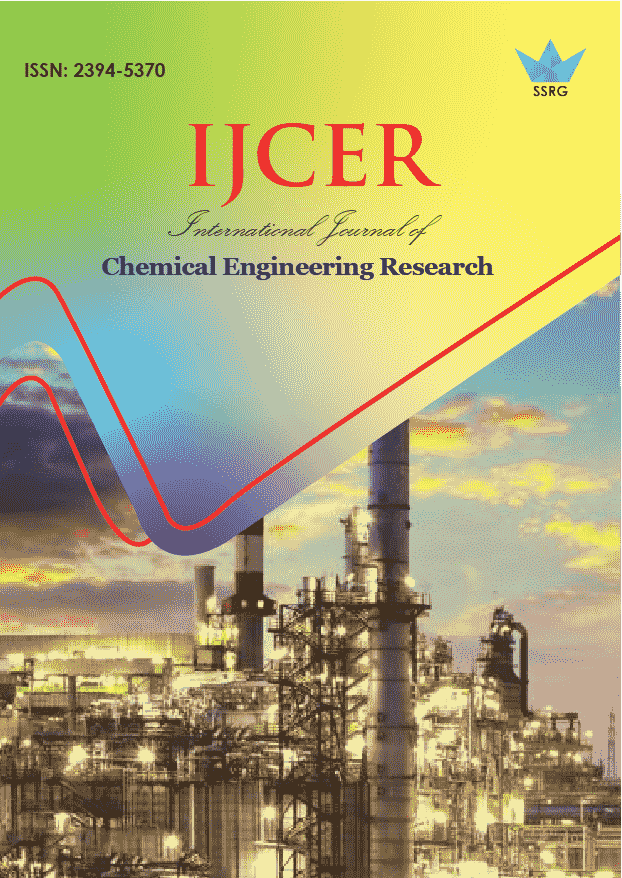Tensile, Thermal, and Morphological Belongings, with Consumption of Agro Ravage Polymers into PVC/NBR Alloys

| International Journal of Chemical Engineering Research |
| © 2015 by SSRG - IJCER Journal |
| Volume 2 Issue 1 |
| Year of Publication : 2015 |
| Authors : Dr.A.Bhavana, M.Johnkarol |
How to Cite?
Dr.A.Bhavana, M.Johnkarol, "Tensile, Thermal, and Morphological Belongings, with Consumption of Agro Ravage Polymers into PVC/NBR Alloys," SSRG International Journal of Chemical Engineering Research, vol. 2, no. 1, pp. 11-14, 2015. Crossref, https://doi.org/10.14445/23945370/IJCER-V2I1N2P102
Abstract:
Poly (vinyl chloride)/nitrile butadiene rubber (PVC/NBR) alloys were melt-mixed by means of a Brabender Plastic categorize at 180◦C and 60 rpm rotor velocity. Alloys obtained by melt integration from PVC and NBR were formulated with wood flour- (WF-) based olive remainder, an ordinary byproduct starting olive oil removal production. WF was increasingly augmented from 0 to 40 phr. The property of WF loadings on the tensile properties of the fictitious samples was inspected. The torque rheometry, which is a meandering suggestion of the melt power, is reported. The example of water uptake for the composites was checkered as an occupation WF loading. The fissure mode and the excellence of bonding of the alloy with and exclusive of filler are deliberate using electron scanning microscope (SEM). Even though its physical and chemical properties vary depending on the polymer’s masterpiece of nitrile, this appearance of synthetic rubber is unusual in being normally opposed to oil, fuel, and other chemicals.
Keywords:
NBR, RPVC, TPE, SEM
References:
[1] AhmadMousa, Gert Heinrich, Bernd Kretzschmar, UdoWagenknecht, and Amit Das, Utilization of Agro waste Polymers in PVC/NBR Alloys: Tensile, Thermal, and Morphological Properties, Hindawi Publishing Corporation International Journal of Chemical Engineering Volume 2012.
[2] Y. Song, Q. Zheng, and C. Liu, “Green biocomposites from wheat gluten and hydroxyethyl cellulose: processing and properties,” Industrial Crops and Products, vol. 28, no. 1, pp. 56–62, 2008.
[3] H. D. Rozman, G. S. Tay, R. N. Kumar, A. Abusamah, H. Ismail, and Z. A. Mohd, “The effect of oil extraction of the oil palm empty fruit bunch on the mechanical properties of polypropylene-oil palm empty fruit bunch-glass fibre hybrid composites,” Polymer-Plastics Technology and Engineering, vol. 40, no. 2, pp. 103–115, 2001.
[4] L. Av´erous and F. le Digabel, “Properties of biocomposites based on lignocellulosic fillers,” Carbohydrate Polymers, vol. 66, no. 4, pp. 480–493, 2006.
[5] A. Mousa, G. Heinrich, U. Gohs, R. H¨assler, and U. Wagenknecht, “Application of renewable agro-waste-based olive pomace on the mechanical and thermal performance of toughened PVC,” Polymer-Plastics Technology and Engineering, vol. 48, no. 10, pp. 1030–1040, 2009.
[6] A. Mousa, G. Heinrich, and U. Wagenknecht, “Thermoplastic composites based on renewable natural resources: UN plasticized PVC/olive husk,” International Journal of Polymeric Materials, vol. 59, no. 11, pp. 843–853, 2010.
[7] L. Fama, A. Mˆonica, B.Q. Bittante, P. J. A. Sobral, S.Goyanes, and L. N. Gerschenson, “Garlic powder and wheat bran as fillers: their effect on the physicochemical properties of edible biocomposites,” Materials Science and Engineering C, vol. 30, no. 6, pp. 853–859, 2010.
[8] T. G. Vladkova, P. D. Dineff, and D. N. Gospodinova, “Wood flour: new filler for the rubber processing industry. II. Cure characteristics and mechanical properties of NBR compounds filled with corona-treated wood flour,” Journal of Applied Polymer Science, vol. 91, no. 2, pp. 883–889, 2004.

 10.14445/23945370/IJCER-V2I1N2P102
10.14445/23945370/IJCER-V2I1N2P102